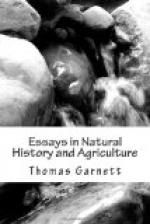I will now mention a few of the opinions respecting the various species of the Salmon, and also my own, when they are at variance with the generally received ones, and give the facts and reasonings which have induced me to form those opinions, and I shall be very glad, if I am in error on any of these points, if some one of my readers, better acquainted with the subject than I am, will take the trouble to set me right. It seems to be the opinion of many, indeed of most persons, that the Salmon spawns from November to February, that the young fry, or Smolts, go down to the sea in the April or May following; my own opinion is that they stay in the river much longer. The Grilse is by many believed to be a distinct species, whilst others stoutly maintain that it is a young Salmon.
The testimony of the witnesses from the Severn, the Wye, the Lee, near Cork, and the Ness (see the evidence given before the Select Committees of the House of Commons in 1824 and 1825), would lead one to suppose that the fish were in best season from November to March, whilst the evidence of the witnesses from other parts of the kingdom goes to prove that this is the very worst period for catching them.
One maintains that each river has its own variety of fish, which can be distinguished from the fish of any other river; another contends that there is no such difference; a third states that stake nets are exceedingly injurious to the breed of the fish; and a fourth attests that stake nets only catch the fish when they are in the best season, that neither Kelt nor fry are taken in them, and that if they were prohibited it would only be preserving the fish for the grampuses and seals;—in short, the evidence regarding both their habits, and the best mode of catching them, having in view the preservation and increase of the breed, is so completely contradictory as to leave a doubt in the mind of every one who reads it, and has no other means of forming an opinion. I will endeavour to show in some instances which of the testimonies is correct, and it will be for my readers to judge how far I succeed, and I hope they will be so obliging as to correct any error into which I may fall.
First.—It is my opinion that the fry of Salmon are much older when they leave the river than seems to be generally supposed, and that the growth of this fish is by no means so rapid as it is considered to be by those who have written upon the subject. For several years previous to 1816 the Salmon were unable to ascend into the upper parts of the river Wharfe, being prevented either by the high weirs in the lower parts, or by some other cause, and of course there were no Smolts or Par; but in that year either the incessant rains of that summer or rumours of the formation of an association for the protection of fish, or some other unknown cause, enabled some Salmon to ascend the river, thirty or forty miles, and to spawn there. In the next spring, 1817, there were




